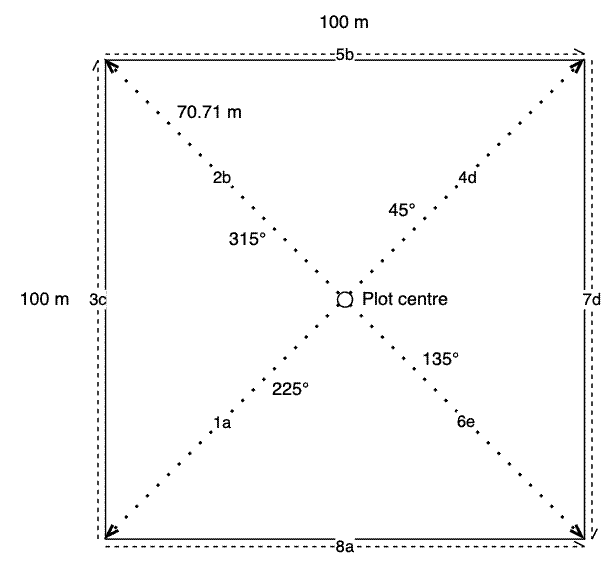Creating perfectly square permanent plots in dense woodland ecosystems can be a challenge. It’s very easy to end up with something more like a diamond or a rhombus, unless care is taken to measure the diagonals of the plot.
Previously I have set up one hectare permanent woodland tree sampling plots by starting at the SW corner of the plot, then running tapes at 90° going N and E for 100 m to form the W and S edges, respectively. Then to ensure that the edges are actually at 90° you run a tape along the hypotenuse of those edges, which should be 141.42 m long. Then you construct the other two edges (N, E), ensuring that they meet at 100 m, and finally check the length of the other hypotenuse is 141.42 m. The principal drawback of this method is that it requires a tape measure that can cover 141.42 m, or else you have to mess about with two tapes or a long piece of string. Covering a straight distance of 141.42 m is difficult because you often can’t see the person standing at the opposite corner. Using 100 m tapes, this method requires a minimum of six tapes. Alternatively you can measure smaller hypotenuse angles at intermediate points along the edges, e.g. at 10 and 25 m, but this means you will have to do many more measurements.
Below I present an alternative method that I think overcomes these problems.
Start in the centre of the plot. Run a tape measure going SW (225°) to 70.71 m, using a sighting compass to guide. Run another tape going NW (315°), also to 70.71 m. Run a tape measure between the ends of these two tapes, which should equal 100 m. Adjust the NW tape to get 100 m. Run a tape going NE (45°) to 70.71 m. Run a tape from NW to NE, which should equal 100 m. Adjust the NE tape to get 100 m. Run a tape going SE (135°) to 70.71 m. Run a tape from NE to SE, and another from SW to SE. Triangulate all three tapes running to the SE corner to get 100 m along the edges.
This process requires only five 100 m tapes and means that you don’t have to span 141.42 m to traverse the full diagonal of the plot.
It requires 5 metal poles. One for each corner and one for the centre.
The diagram below shows the layout of tape measures to create a plot in this way. The dotted lines show temporary tape measures, while the dashed lines show permanent tape measures, which form the edges of the plot. The tape measure lines are numbered in the order they should be laid out. The letters next to the numbers (a-e) identify the tape measures. See that line 2b and 5b use the same tape measure, for example.

If you did want to stick with the method where you start at the SW corner but wanted to avoid the problem of running a tape 141.42 m along the hypotenuse of the entire plot, you could do hypotenuse measurements at intermediate points, e.g. 25 m (35.36 m) and 50 m (70.71 m). This eliminates the need for tapes longer than 100 m, but does require four or more measures of the hypotenuse, one for each pair of edges.